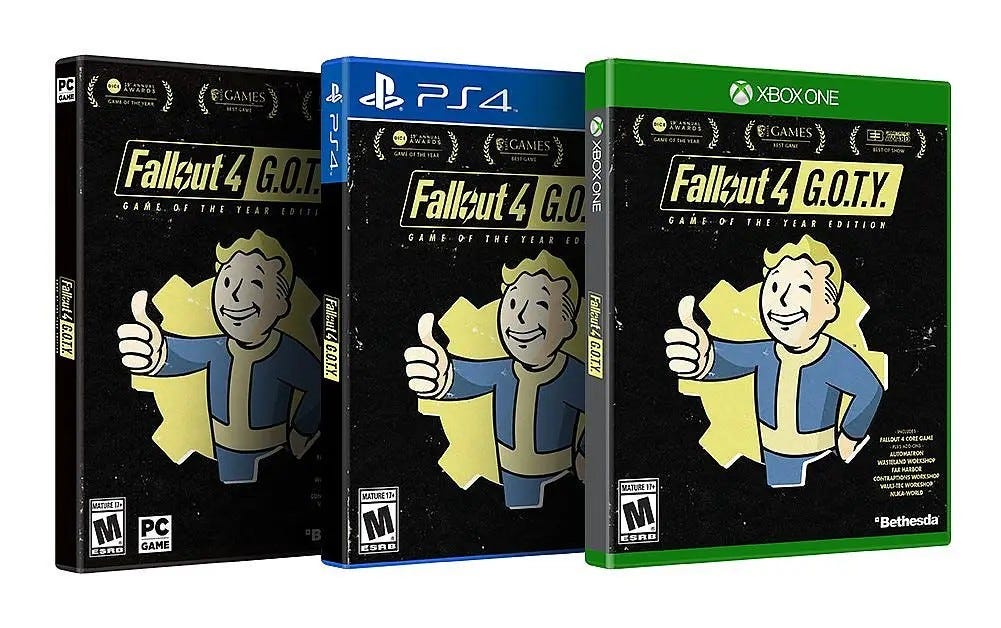The Price Is... Right?
Nintendo’s pragmatic approach on value in the face of economic uncertainty ushers in a tumultuous era for an industry grappling with increasing costs and unrealistic expectations.
UPDATE: 7:10 PM, May 12, 2025 - Since publication this morning, President Trump has struck a deal with China to reduce tariffs for 90 days and essentially “reset” trade relations, with US tariffs on Chinese imports being reduced from 145% to 30% and Chinese tariffs from 125% to 10%. Time will tell if this signals a return to the prices pre-tariff, but I doubt Nintendo or the other console manufacturers will reverse course on the price adjustments they’ve already made.
U.S. and China agree to slash tariffs for 90 days as trade talks continue - May 12, 2025
The grand unveiling of their next generation of consoles - the Nintendo Switch 2 - was supposed to be an exciting event with big fanfare: a new generation of hardware with more power, higher levels of graphical fidelity, innovative features, and the promise of new entries in some of their most popular franchises. But since the highly anticipated reveal of the new console in a long-awaited Nintendo Direct presentation on April 2nd, the online discourse has been equal parts elated with excitement, muddled with confusion, and mired with controversy, particularly regarding the departure of pricing trends from generations’ past as a reaction n the face of the economic realities of inflation, increasing costs of development, and an international trade war launched by Donald Trump that have already had a significant effect across the industry.
Nearly a decade ago, the original Switch pioneered the premium handheld market, launching at $299 alongside a steady cadence of AAA titles. But the video game console landscape has since changed. The discourse surrounding the price of the new hybrid console itself - a whopping $450 for the base model and $500 for a “Mario Kart World” digital bundle - has since stabilized, considered fair in a market now shared with the likes of $500+ handheld PC powerhouses such as Valve’s Steam Deck, Lenovo’s Legion GO, and Asus’ ROG Ally (The cheapest Steam Deck being the . The main gripe among gamers has quickly shifted to Nintendo’s software prices, “evergreen” prices which Nintendo is notoriously known to maintain from cradle to grave over the course of a game’s life cycle (with the exception of the occasional holiday sale). Nintendo’s decisions regarding pricing for its most popular recent titles - especially in the face of Bethesda Game Studio’s and Virtuous’ collaborative $50 remaster of “The Elder Scrolls IV: Oblivion” - has predictably left the gaming community reeling with sticker shock and bewilderment. But these decisions must be understood in the acknowledgement of historical context and Nintendo’s existence as a Japanese company with a VERY different perspective on value. Let’s take a look at some historical precedent for the prices we’re seeing now, how we got here, and why Nintendo may be making the decisions they are, whether we like it or not.
THE RETURN OF VARIABLE GAME PRICING
As a nineties kid, I wasn’t old enough to know or care how variable and HIGH the cost of gaming actually was throughout the 4th and 5th console generations. The cost of games was something for my parents to worry about. With inflation rising steadily in recent years, the cost of gaming in the nineties has become a trending topic and it’s been illuminating to realize just how good we’ve had it for so long. Check out these Toys ‘R’ US newspaper ads from around that time:
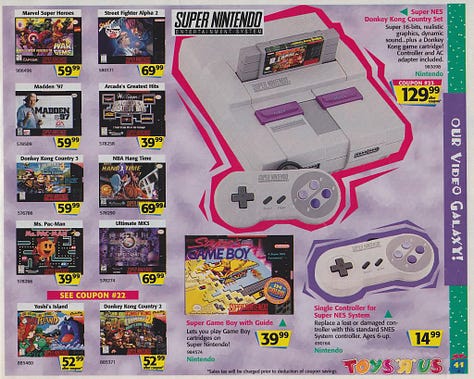
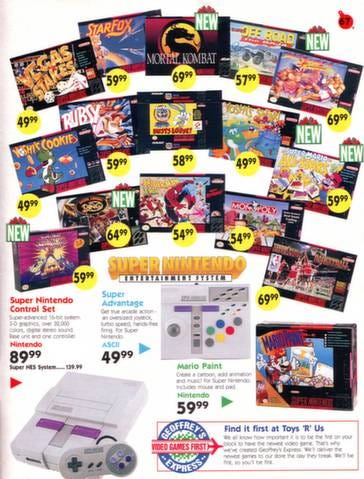
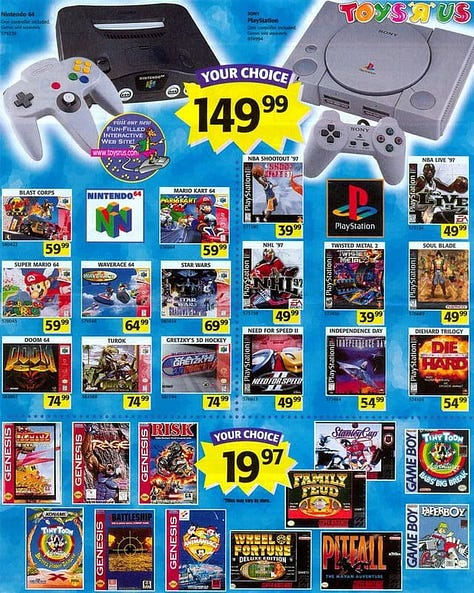
While Nintendo 64 titles were inherently more expensive due to the increased cost of manufacturing cartridges over compact discs (one of the major reasons publishers and developers began to favor Sony’s PlayStation) the key point here is that prices remained “variable” until the 6th console generation came around and virtually standardized the $50 price point across the Nintendo GameCube, Sony PlayStation 2, and Microsoft Xbox consoles. This standard became $60 for the two subsequent generations after that, and it is only until recently that we’ve seen the current generation reach the $70 prices we haven’t seen since the nineties, with Sony being the first to standardize this rate across all its new and upcoming first party PS5 titles. Nintendo was the last to maintain $60 for its Nintendo Switch releases, before adopting the $70 price point with one particular game - “The Legend of Zelda: Tears of the Kingdom”, the price causing a minor controversy at the time because of the game’s development already reusing assets from its ground-breaking predecessor, “The Legend of Zelda: Breath of the Wild”.
$70 seems high today for the cost of a video game today but according to Infographic Website, when we adjust the cost of software in those earlier generations for inflation, “the price of video games has remained relatively stable or even decreased in real terms” - noteworthy in an industry grappling with multi-million-dollar budget bloat, massive development teams, and expensive advancements in tech. Whereas a PS2 game released today would have cost around $91, we’ve enjoyed the luxury of consistent, stable software prices despite decades of ever-changing market conditions.

“The price of video games has remained relatively stable or even decreased in real terms”
Which bring us to “Mario Kart World”, the Switch 2’s killer-app and the biggest target of gamers’ chagrin since the game’s Direct reveal. The game itself looks incredible, but Nintendo has decided to sell the game, both digitally and physically, with an eye-widening MSRP of $80 - an unprecedented move that even Sony and third parties have yet to make outside of deluxe edition bundles. Even I questioned Nintendo’s judgement here, saying “I don’t think “Mario Kart” is worth $80”. Nintendo of America’s (NoA) current President and COO Doug Bowser (yes, that is his real name) stressed that this will not the standard for every new release - the upcoming “Donkey Kong Bananza” will run you $70 - and tried to put this variable pricing model into perspective during his interview with The Washington Post’s Gene Park:
“What you see right there is variable pricing… We’ll look at each game, really look at the development that’s gone into the game, the breadth and depth of the gameplay, if you will, the durability over time and the repeatability of gameplay experiences.
“Those are all factors, and there’s many more that go into consideration of what is the right price point for the game. So I think you can anticipate that there will be variable pricing, and we haven’t set a benchmark.”
Nintendo boss Doug Bowser explains the $80 price for ‘Mario Kart World’ - April 7, 2025
With the context of our economic reality, $80 seems more reasonable when you consider the rate of inflation finally catching up to and disrupting an increasingly expensive industry. The game (as far as we know) is free of any MTX implementation and is likely to be the sole “Mario Kart” game released for the system. Free updates ala “Nintendo Switch Sports” or NSO Expansion Pass perks ala the Booster Course Pass for “Mario Kart 8” are almost certainly on the roadmap for the game’s future prospects. Holiday sales, bundles, and discounts are also something to consider, which is what Nintendo may have also had in mind considering the $80 price point. The game will sell gangbusters at launch despite the costly point of entry, and attractive deals that slash the price anywhere from 20 to 30 percent will bring it more in line with past expectations and drive lifetime sales even further. You get what you pay for and $80 for seven years of kart-racing fun - considering inflation and future content drops - is pragmatic while still being worth the price of admission.
ZELDA, SWITCH 2 EDITIONS, AND ENTITLEMENT
Another point of contention are the details regarding pricing and content for original Switch games enhanced by the new hardware. Nintendo had done a poor job clarifying Switch 2 Edition Upgrade Pack pricing, formats, and included content to both enthusiasts and average consumers alike, with details drip-fed across the internet the last couple of weeks. Is the upgrade already included on premium Switch 2 carts, or is an upgrade pack download required? Yes. Certain games will receive free updates vs. the premium “Switch 2 Edition” moniker that designate more substantial enhancements. Then it was discovered that out that the $10 Switch 2 Edition Upgrade Packs for “Breath of the Wild” and “Tears of the Kingdom” would be included within the Nintendo Switch Online + Expansion Pass subscription (which was welcome news to me, as a current subscriber).
There is precedent for these sorts of upgrade packs. Last year, Sony offered existing players of “Horizon: Zero Dawn” a $10 upgrade fee for that game’s PS5 remaster, but for the remastered, PS5 version of their 2018 “Marvel’s Spider-Man” release, it was locked behind a convoluted bundle with “Marvel’s Spider-Man: Miles Morales”. Nintendo is taking a page from the same playbook with their Switch 2 Editions, and like Sony, Nintendo is using variable pricing depending on the depth and content of each game’s upgrade - “Breath of the Wild” and “Tears of the Kingdom” cost $10 each for enhanced resolution, frame rates, and Nintendo Switch App integration whereas “Kirby and the Forgotten Land” and “Mario Party Jamboree”, both of which feature entirely new assets and gameplay modes, will cost $20. Got all that?
None of this information is easy to convey in a clear and concise way, no matter how you present it. And the frustration from lack of clarity is only amplified by the discovery that the “Breath of the Wild Expansion Pass” will not be included in the Switch 2 Edition of the game. This is where the proverbial mountain has been made out of the molehill, where reasonable online discourse has descended into irrationality and cynicism.
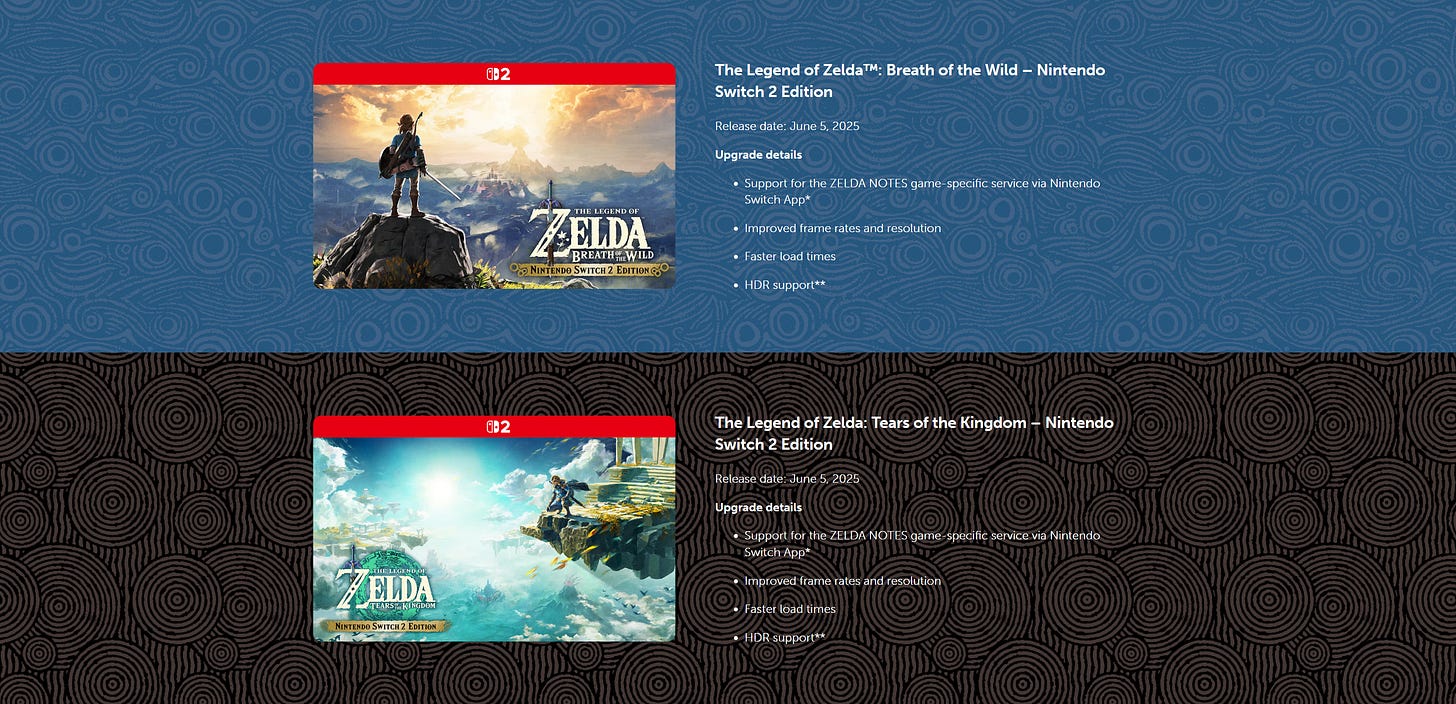
The original Switch release of “Breath of the Wild” remains, to this day, a $60 standalone title. The upgrade pack costs an additional $10, making the complete, Switch 2 Edition $70, whether you’re upgrading or purchasing the new, red cartridge for the first time. If you want the $20 Expansion Pass and its included features, the total package will cost you $90 when all is said and done. Painfully expensive for one game, yes, but still reasonable - They want a return on their investment. Nintendo hasn’t marketed this re-release as a definitive, all-inclusive edition, despite the game being over seven years old so it shouldn’t be expected to be included in the offering. The original release remains a complete and fully realized experience, while the Expansion Pass remains exactly that - additional content that offers more than what the original game has to offer. Even so, gamers have expressed their frustration and bewilderment at the cost of what they consider to be an incomplete package, even as millions remain more than happy to spend hundreds of dollars for cosmetics in ongoing, live-service titles like Fortnite and Destiny 2.
This $90 narrative has since been reported by multiple online outlets, but I’d like to highlight Forbes’ Senior Contributor Paul Tassi’s blistering analysis of this controversy from Forbes:
“The operative word here from fans is “greed.” Yes, that may be a similar cost to the OG players who paid for the DLC separately. But it’s 2025 and when you make a “final” new-gen version of a game that quite literally was also launched on the Wii U in 2017, it’s pretty understandable that fans would be upset there’s simply not a “complete” version of the game for a reasonable cost. $90 for a game this old just to get the finalized experience is ridiculous”
Nintendo Says Switch 2 ‘Breath Of The Wild’ Is $90 With DLC - April 11, 2025
I understand Tassi and others’ fundamental frustration with not having this be a “final”, definitive collection, but I don’t believe Nintendo is being greedy here. Again, they simply want a return on their investment. But to understand why gamers are balking at what ultimately amounts to a $90-price tag for a seven-year-old game, we need to understand how they’ve been conditioned to expect deep discounts while receiving more content, particularly in the West.
.For years, Western gamers have become accustomed to “Game of the Year” editions where the base game is re-issued with all of the downloadable content included in the package and often at a drastically lowered price. Bethesda is known to do this with the “Fallout” and “Elder Scrolls” series. At the time of this writing, “Fallout 4: Game of the Year Edition” is available to download for $40, including all 6 add-on DLCs (A huge bargain, considering I purchased the game at launch a decade ago for $60, no DLC included). Third party publishers like Ubisoft are known to offer steep deals for their games a year or several later, with a $160 bundle of “Assassin’s Creed Origins”, “Odyssey”, and “Valhalla” routinely available for $31.99 on the Xbox Marketplace. At the time of this writing, the physical version of “Star Wars Outlaws” is discounted for $35 at Target and the game has yet to reach one year anniversary on the market (it released last August). This practice isn’t exclusive to Western publishers, either - Capcom and SEGA hold regular sales on both their flagship “Sonic the Hedgehog” and “Resident Evil” titles.
Third-party publishers like these routinely slash prices to encourage the occasional surge in sales after a drop off following initial release. Over time, the value in these titles diminish, but Nintendo is unique in that it does not devalue their own products - rare 20 to 30 percent discounts on their most popular titles being the exception - even after several years on the market. And they don’t have to. Simply put, they retain these evergreen prices on software because they sell, regardless of how much time has passed. And because the brand is so recognizable and trusted, there will always be an audience for their games. The Expansion Pass is non-essential, additional content to an already complete experience and players shouldn’t feel entitled to this content because of its age and the market behavior of other publishers, each with their own business interests to consider. Through not offering the Expansion Pass though the Switch 2 Edition, Nintendo seeks to maintain its value as an additional product - we should understand and respect their stance on this, even if we don’t agree with it.
NINTENDO SWITCH 2 WELCOME TOUR NOT BEING A FREEBIE IS A MISTAKE
I’m probably coming off as an enormous Nintendo simp by now, but I won’t defend everything the company has done or is doing as we approach the release of the Switch 2. The decision to make “Nintendo Switch 2 Welcome Tour” a paid piece of software rather than a free pack-in title (for $10 through Nintendo eShop) is a profoundly wrong one, but there are specific reasons for this bizarre decision. In his recent business memoir, “Disrupting the Game: From the Bronx to the Top of Nintendo,” former Nintendo of America COO Reggie Fils-Amié conveys an anecdote on how the Wii almost shipped without “Wii Sports” as bundled software and how he worked to convince the executive leadership in Japan otherwise:
“I advocated packing “Wii Sports” with Wii so that every consumer would get access to this great content. After I made this suggestion, Mr. Iwata paused long enough for me to notice the faint buzz of the incandescent lighting in his office and get uncomfortable. ‘Reggie,’ Mr. Iwata said, ‘Nintendo does not give away precious content for free. We work hard to create special experiences. It is unique software that motivates consumers to buy our hardware. And we expect to sell these games over extended periods of time. No, we should not pack in ‘Wii Sports.' ‘
‘Mr. Iwata, I understand the value of our software. I know unique software has always differentiated Nintendo. But we know that Wii is a very different concept in the history of video games. Wii focuses on unique game play. The goal of Wii is to expand gaming from its current niche to a mass-market medium. ‘Wii Sports’ has the power to do this. ‘Wii Sports’ can be a unifying element for all players of the system and be a key motivation for people to buy the system and have fun immediately.’
‘Plus, Mr. Iwata, I know Nintendo has history using packed-in software to drive a system.’”
While legendary game designer Shigeru Miyamoto (creator of Mario, Zelda, Donkey Kong) recognized the need for demonstrative software, pitching a minigame collection that would eventually release as “Wii Play” as a substitute for Wii Sports, Reggie suggested that that title be released with the Wii Remote as a pack-in instead, while asserting his view that “Wii Sports” was the title best suited to selling the hardware both practically and as a concept.
‘I watched Mr. Iwata’s and Mr. Miyamoto’s faces and then heard the translation into English. “Reggie is right. ‘Wii Sports’ does a much better job to achieve our objective of getting consumers to understand Wii immediately. And this minigame collection is not a fully formed game that will command full price in our market. We should think about how to best use this software to achieve our objectives. Including this with the Wii Remote accessory is unconventional, but it would get more Wii Remotes in the hands of our consumers.”
So now Mike and I were trying to get agreement to two different bundles, and the world’s best game designer was not happy. The ever-present smile and impish squint of Mr. Miyamoto’s eyes were gone. “Neither of you understands the challenges of creating software that people love to play. This is something we constantly push ourselves to do. We do not give away our software,” Mr. Miyamoto stated.
How Reggie Fils-Aimé got ‘Wii Sports’ included with the Wii - May 3, 2022
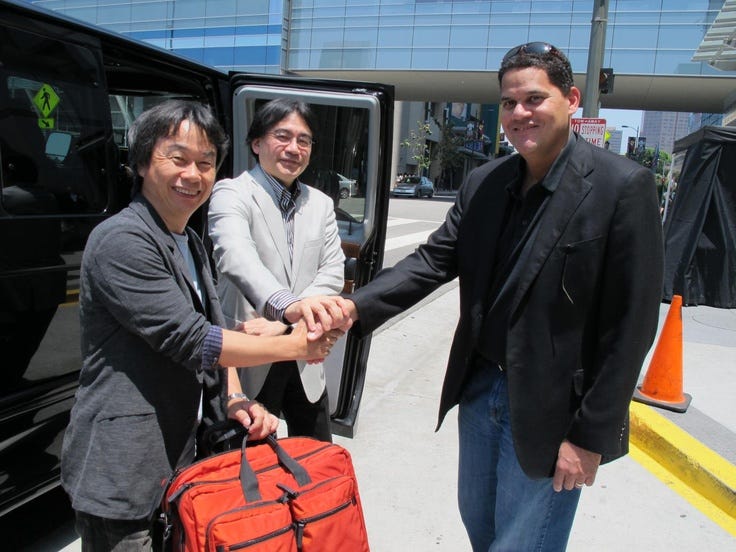
The complete account is much more interesting, and I encourage you to check out his book to get the full story, among his other experiences at Nintendo and beyond. But back to the point: Nintendo does not like to give away software for free and has only done so when making amends to early adopters (ala the 3DS Ambassador program) or when the included software is essential to showing off the features of the console they’re trying to sell. When asked in an interview with IGN’s Logan Plant about why “Nintendo Switch 2 Welcome Tour” is not being considered as a pack-in freebie, NoA's Vice President of Product and Player Experience Bill Trinen explained:
“I think there are people who are particularly interested in the tech and the specs of the system and things like that, for them I think it's going to be a great product. It's really for people that want more information about the system rather than necessarily a quick intro to everything it does.
‘And for that reason and just the amount of care and work that the team put into it, I think it was decided that, 'Yeah, this feels like $9.99 is not an exorbitant price. It feels like a good value for what you're getting out of the product.'"
While I acknowledge the effort the development team has put into this project and realize it isn’t essential to understanding the concept of the Switch 2, past strategic success and just good business sense make it obvious “Welcome Tour” should be offered as a bundled title for new buyers. The decision to go in the opposite direction is even more bizarre when you consider that Sony bundled “Astro’s Playroom” - a more substantial tech demo/platformer that showcased the console’s controller haptics - with PS5’s for new players to enjoy. Reggie has seemingly weighed in on this decision over on X, sharing the very same “Wii Sports” story he described in his book. There’s no doubt in my mind had Reggie still been President of NoA during these discussions, he would have firmly advocated for “Welcome Tour” to be bundled with the hardware, at least in Western markets. This is a detrimental, out-of-touch decision by Nintendo, especially when the game’s design as a sort of digital tutorial lends itself well as introductory software, their competitors have offered more compelling software for less, and consumers are already struggling to pay their bills and afford basic goods.
A NEW ERA TAKES SHAPE
Apart from Nintendo, companies are taking action across the board in the face of rising development costs and aggressive trade policy. Until two weeks ago, Microsoft had been mum on what steps it would be taking with Xbox to address the industry’s shifting market, following Sony and Nintendo’s respective actions. But that changed on May 1st when Microsoft formally announced significant price increases across the Xbox brand. Most notably, the Xbox Series X/S consoles MSRPs were increased by $100/$80 respectively, with the company expecting to “adjust the pricing of some of our new, first-party games starting this holiday season to $79.99.”
Sound familiar? As many are eager to solely blame a sitting President for high gas prices and other economic disadvantages, many predicably blamed Nintendo for setting this $80 precedent with “Mario Kart World”. But regardless of who initiated them first, these were changes that were “going to happen sooner or later,” stressed former PlayStation (Sony Interactive Entertainment) President and industry icon Shuhei Yoshida in an interview with PlayStation Inside’s Yacine Ouali:
“We live in contrasting times, where inflation is real and significant, but people expect games that are ever more ambitious and therefore expensive to develop to cost the same. It’s an impossible equation.
Everything in video games today is more advanced and more technologically demanding than ever before, and therefore requires more resources. Each publisher or manufacturer sets the price of its games, of course, but in the end the heart of the matter lies in production costs. And that’s why industry actors are so keen to diversify their revenues, in order to continue producing the AAA games that the public buys before anything else…. In any case, a balance must be found between production costs and game prices.”
An interview with Shuhei Yoshida, former president of PlayStation (English Version) - May 5, 2025
In the wake of Microsoft’s press release, I suppose we should be grateful Nintendo mercifully decided to raise the costs of Switch 2 accessories over the console itself, having been pigeon-holed by announcing pricing details the same day as Trump’s unilateral, reciprocal, and selectively vindictive “Liberation Day” tariffs. And the $450 price tag on the console at launch is not a perpetual guarantee, as global Nintendo President Shuntaro Furukawa explained in the company’s 2025 fiscal year press conference:
“Our basic policy is to recognize tariffs as a cost and incorporate them into pricing in any country or region where they are imposed. However, considering that this year marks the launch of new hardware for the first time in eight years, we also prioritize maintaining the momentum of this critical platform for the dedicated gaming console business and the early adoption and expansion of new hardware. If the prerequisites for taxation change, we plan to consider various factors such as the market environment and discuss what kind of price adjustments would be appropriate.”
Fiscal Year Ending March 2025 Earnings Presentation (Online) Q&A (Summary)
I expect Sony, too, will make further changes to its pricing model in the coming months, as the trade war between the US and China continues, an issue in which the US President can be held directly responsible for, particularly regarding the 145% tariff on the importation of goods (including consoles) manufactured in China. While high tariffs and ongoing trade wars are proving to be consequential for the industry in and of themselves, they are threatening to exacerbate issues that already exist, namely the rate of inflation and the rising costs of development, AAA or otherwise. This is a multifaceted, complex web of issues that will impact every console manufacturer and video game publisher across the board as they learn how to navigate the costs of inconsistent trade policy, sophisticated game development, and rising inflation - it is rarely the fault of one individual, company, or variable.

As much as I’d prefer “Mario Kart World” and other premium releases to cost less than $80, I understand the reasons why Nintendo, Microsoft, and Sony are making these decisions. Just as these businesses have had to adjust their business to manage profitability as market conditions fluctuate, so too must we adapt to an ever changing and (de)volving economy. We need to look beyond the surface-level accusations of greed that dominate the discourse and think critically, understanding that even when they make mistakes, these are companies that must generate revenue to sustain their businesses. Context is even more important to consider for a company like Nintendo that exists within a culture that defines value differently than those in the West, especially in business. We must acknowledge that, for as long as we’ve enjoyed the luxury of steady, affordable prices for our favorite games, the realities of rising development costs, growing inflation, and an inconvenient trade war currently impacting both are the reasons why Nintendo and other companies must consider pragmatic value propositions while pursuing consumer friendly practices wherever they can - even if we must hold them accountable when they don’t seize these opportunities as we head into another generation of gaming.






